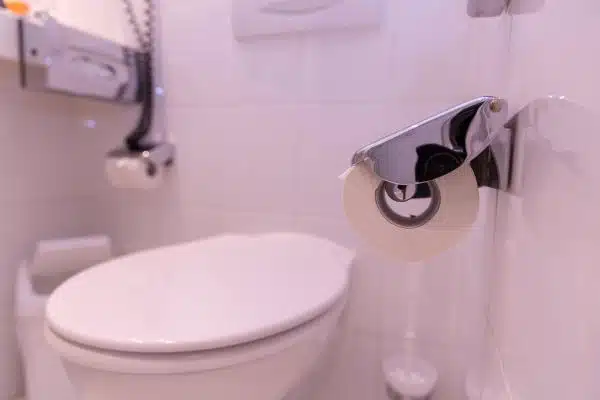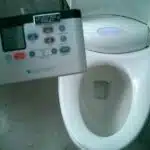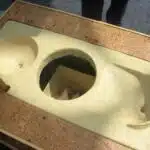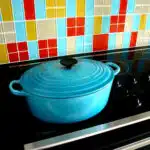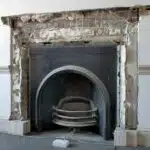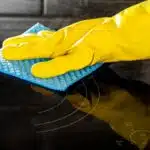As a professional house cleaner, I have seen my fair share of dirty toilets. While many people may find cleaning the toilet to be a daunting task, it is an essential part of maintaining a clean and healthy home. Properly cleaning a toilet not only ensures that it looks presentable, but it also helps to prevent the spread of germs and bacteria.
In this article, we will discuss the proper technique for cleaning a toilet. From gathering the necessary supplies to disinfecting every surface, we will cover everything you need to know in order to keep your bathroom sparkling clean. Whether you are a seasoned house cleaner or simply looking to improve your home maintenance skills, this guide will provide you with all the information needed to properly clean your toilet and create a more hygienic living space for yourself and others.
Gather Your Supplies
As a professional cleaner, the key to properly clean a toilet is having the right supplies. Before starting the cleaning process, you should make sure that everything is organized and within reach. This will save you time and effort while cleaning the toilet. Some of the basic supplies required include rubber gloves, toilet brush, cleaning solution, scrubber or sponge, and paper towels.
When it comes to choosing your cleaning products, you can opt for eco-friendly alternatives that are less harmful to both the environment and yourself. Instead of using harsh chemicals that contain bleach or ammonia, look for cleaning solutions that are plant-based and free from artificial fragrances. These natural alternatives work just as well in disinfecting your toilet without leaving behind any toxic residues.
After gathering all your supplies and selecting an eco-friendly cleaning solution, it’s time to put on protective gear before proceeding with the cleaning process. This includes wearing rubber gloves to protect your hands from coming into contact with bacteria or germs that may be lurking inside the bowl. By taking these necessary precautions, you can ensure not only a sparkling clean toilet but also a hygienic one.
Put On Protective Gear
- Prior to cleaning a toilet, it is essential to put on protective gear, such as gloves, a mask, and goggles.
- Gloves should be non-porous, with a snug fit and long enough to cover the wrists.
- A mask should be worn to avoid breathing in airborne particles.
- Goggles should fit snugly to the face, and be securely fastened to prevent them from shifting.
- All protective gear should be inspected prior to use, to ensure that it is in proper condition.
- After cleaning, all protective gear should be removed and disposed of properly.
Wear Gloves
It’s no secret that cleaning a toilet is not the most pleasant task in the world. However, it’s a necessary one to ensure the health and safety of those using it. When it comes to putting on protective gear, wearing gloves should be at the top of your list. The benefits of gloves are numerous, including protecting your hands from harmful bacteria and chemicals found in cleaning products.
As a professional house cleaner, I highly recommend wearing gloves while cleaning a toilet. Not only does it protect your skin from harsh chemicals, but it also prevents the spread of germs and bacteria that can lead to illness or infection. There are alternatives to gloves such as using a rag or sponge, but these options don’t provide the same level of protection as gloves do.
In conclusion, when cleaning a toilet, always put on protective gear before starting the task. Wearing gloves is an essential part of this process as it helps protect your hands from harmful chemicals and bacteria. While there are alternatives to gloves, they don’t offer the same level of protection and should be avoided if possible. Remembering to wear gloves will make cleaning your toilet less daunting and help keep you safe and healthy in the long run.
Put On A Mask
When it comes to cleaning a toilet, wearing protective gear is essential to ensure the safety and health of those performing the task. In addition to gloves, it’s also important to consider wearing a mask. Properly wearing a mask can help protect against harmful chemicals and bacteria found in cleaning products.
There are several ways to properly wear a mask while cleaning a toilet. Firstly, make sure the mask covers both your nose and mouth completely. It should fit snugly but comfortably around your face without any gaps or leaks. Secondly, avoid touching the mask while wearing it, as this can cause contamination. Lastly, dispose of the mask immediately after use and wash your hands thoroughly.
There are different types of masks available for cleaning toilets, including surgical masks and N95 respirators. Surgical masks are more commonly used for everyday cleaning tasks and provide basic protection against dust and particles. On the other hand, N95 respirators offer more advanced protection against harmful chemicals and bacteria but require proper fitting and training before use.
In conclusion, wearing a mask is an important part of putting on protective gear when cleaning a toilet. By following proper guidelines for wearing a mask and choosing the appropriate type of mask for the task at hand, you can help protect yourself from harmful chemicals and bacteria commonly found in cleaning products.
Put On Goggles
When it comes to cleaning a toilet, protective gear is essential to ensure the safety and health of those performing the task. The common protective gear includes gloves and mask. However, one may wonder whether wearing goggles is necessary or overkill. In reality, goggles are an important piece of protective gear when cleaning a toilet, as they protect your eyes from harmful chemicals and bacteria that can splash back up during the cleaning process.
Wearing goggles while cleaning a toilet can help prevent eye irritation or even blindness caused by contact with harsh chemicals. It’s important to choose goggles that fit securely around your eyes and have a clear view so you can see what you’re doing. In addition to protecting your eyes, wearing gloves while cleaning is also crucial for preventing skin irritation or infection from exposure to germs and harsh chemicals.
Overall, it’s always better to be safe than sorry when it comes to cleaning a toilet. Wearing protective gear like gloves and goggles ensures not only your safety but also the cleanliness of the toilet itself. So next time you clean a toilet, be sure to wear all necessary protective gear including goggles, gloves, and mask.
Pre-Flush The Toilet
Pre-flushing the toilet is a crucial step in properly cleaning a toilet. Many people overlook this step, but it can make a significant difference in the cleanliness of your toilet. Pre-flushing involves flushing the toilet before you begin cleaning it to remove any loose debris or dirt that may be present in the bowl. This will make it easier to clean and prevent any stains from becoming more difficult to remove.
The benefits of pre-flushing are numerous. First, it helps to remove any loose debris or dirt that may be present in the bowl. This makes it easier to clean and prevents any stains from becoming more difficult to remove. Second, pre-flushing helps to prevent cross-contamination between different areas of the toilet. By flushing away any debris or dirt before cleaning, you reduce the risk of spreading germs and bacteria around.
However, there are common mistakes that people make when pre-flushing their toilets. One mistake is not flushing long enough. It’s important to flush for at least 10 seconds to ensure that all loose debris is removed from the bowl. Another mistake is not using enough water when flushing. Make sure that there is enough water in the bowl before flushing so that all debris can be washed away.
With these benefits and common mistakes in mind, pre-flushing should become an essential part of your toilet cleaning routine. In the next section, we will discuss how to apply a cleaning solution to the bowl effectively without damaging your toilet’s surface.
Apply Cleaning Solution To Bowl
After pre-flushing the toilet, it’s time to apply a cleaning solution to the bowl. Think of it as adding soap to a dirty dish before scrubbing it clean. There are many cleaning solution options available on the market, but one of the most effective is white vinegar mixed with baking soda. This natural combination is gentle on surfaces and tough on stains.
To apply the cleaning solution, start by pouring it directly into the bowl. Use enough to cover the entire surface area of the interior. Then, let it sit for at least 10-15 minutes so that it can work its magic before moving on to scrubbing. During this time, you can tackle other cleaning tasks such as wiping down counters or sweeping.
Once enough time has passed, grab a toilet brush and begin scrubbing away at the interior of the bowl. It’s important to note that using a toilet brush has many benefits beyond just getting rid of stains and buildup. The bristles help remove bacteria and other harmful particles from the surface while also helping to prevent future buildup by regularly agitating any debris in the water.
So next time you’re faced with a dirty toilet, remember that applying a cleaning solution and using a toilet brush are two crucial steps in properly cleaning and maintaining your bathroom fixtures. With some elbow grease and persistence, your toilet will be sparkling clean in no time!
Scrub The Bowl With A Toilet Brush
To properly clean a toilet, it is important to scrub the bowl with a toilet brush. The first step in this process is to ensure that you have the correct tools for the job. A toilet brush should be kept near the toilet at all times and should be cleaned after each use to prevent bacterial growth.
Toilet brush maintenance is crucial for effective cleaning. After scrubbing the bowl, rinse the brush thoroughly under hot water and leave it to dry completely. It is also recommended that you sanitize your brush every two weeks by soaking it in a mixture of hot water and white vinegar for at least 30 minutes. This will help to eliminate any bacteria or germs that may have accumulated on the bristles.
For those who are looking for eco-friendly cleaning alternatives, there are several options available. One popular choice is using baking soda and vinegar instead of harsh chemicals. Simply sprinkle baking soda into the bowl, pour in some vinegar, and let it sit for about 15 minutes before scrubbing with your toilet brush. This method not only cleans effectively, but also eliminates odors without damaging the environment or harming your health.
Now that you have successfully scrubbed the bowl with your toilet brush and maintained its proper care, it is time to move onto cleaning the rim and lid. Gently lift up the lid and wipe down both sides with a disinfectant spray or wipe. Pay extra attention to any hinges or crevices where dirt may accumulate. Then move onto cleaning around the rim of the bowl, being sure to reach all areas with your chosen cleaner before flushing away any residue.
Clean The Rim And Lid
Did you know that the rim and lid of a toilet bowl are some of the most commonly neglected areas during cleaning? According to a survey conducted by the American Cleaning Institute, only 45% of people clean these areas regularly. Neglecting these parts can lead to the accumulation of dirt, grime, and bacteria, which can cause foul odors and even illnesses.
To ensure that your toilet is fully cleaned, here are three essential steps for cleaning the rim and lid:
- Use a disinfectant cleaner: Apply a disinfectant cleaner to the rim and lid of the toilet bowl. Be sure to use sufficient amounts of the cleaner to cover all surfaces thoroughly. Allow it to sit for several minutes before scrubbing with a brush or sponge.
- Scrub thoroughly: Use a stiff-bristled brush or sponge to scrub away any dirt or stains on the rim and lid. Pay attention to hard-to-reach spots such as hinges and crevices where bacteria often accumulate.
- Rinse with water: Once you have finished scrubbing, rinse the rim and lid with water until all traces of cleaning solution have been removed. Wipe dry with a clean cloth.
Common mistakes when cleaning these areas include using too little cleaning solution, not allowing enough time for it to work effectively, and neglecting hard-to-reach spots where bacteria may be hiding. An alternative method is to use natural cleaners such as baking soda or vinegar instead of chemical cleaners.
Now that you have learned how to clean the rim and lid of your toilet bowl properly let’s move on to learning how to clean the outside of your toilet without leaving any streaks or residue behind!
Clean The Outside Of The Toilet
To properly clean the outside of a toilet, it is important to gather the necessary cleaning products. Some effective cleaning products for this task include disinfectant sprays, all-purpose cleaners, and vinegar solutions. It is also important to have gloves and a scrub brush on hand to help remove any stubborn stains or buildup.
For those who prefer DIY methods, there are several options available. A mixture of baking soda and water can be used as a gentle abrasive to remove stains and buildup. Lemon juice can also be used as a natural cleaner due to its acidic properties. Simply mix lemon juice with water and apply it to the toilet exterior with a cloth or sponge.
When cleaning the outside of the toilet, it is important not to forget about hard-to-reach areas such as behind the base and around the bottom of the tank. Take your time and thoroughly clean every surface using your chosen cleaning method. Once you have finished cleaning the exterior of the toilet, it’s time to move onto the next step: cleaning the tank and handle.
Transition: Now that we have covered how to properly clean the outside of your toilet, it’s time to move onto another important area – the tank and handle.
Clean The Tank And Handle
Did you know that the toilet tank is one of the most overlooked areas during cleaning? Studies show that 9 out of 10 people do not clean their toilet tanks regularly, leading to bacterial growth and unpleasant odors. Tank maintenance should be an essential part of your toilet cleaning routine.
To start cleaning the tank, turn off the water supply and flush the toilet to drain as much water as possible. Use a mixture of baking soda and vinegar to scrub the inside surfaces of the tank thoroughly. This will help remove any build-up of minerals or mold. After scrubbing, rinse with warm water and wipe dry with a clean cloth.
Next, let’s discuss handle hygiene. The toilet handle is one of the most touched surfaces in your bathroom and can harbor harmful bacteria if not cleaned regularly. To clean it, spray a disinfectant solution onto a microfiber cloth and wipe down the handle thoroughly. Allow it to air dry for at least five minutes before using it again. Remember to clean the handle after each use if someone in your household is sick to prevent cross-contamination.
As you finish cleaning the tank and handle, take time to ensure that they are completely dry before turning on the water supply again. A damp environment can encourage bacterial growth, which will cancel out all your hard work! In addition, always remember to wash your hands thoroughly after cleaning any part of your bathroom. Now that we’ve covered tank maintenance and handle hygiene let’s move on to our final section: use a disinfectant spray for an overall deep clean.
Use A Disinfectant Spray
After cleaning the tank and handle, it’s time to move on to using a disinfectant spray. The benefits of using disinfectant spray are numerous. Firstly, it kills germs and bacteria that may be lingering in the toilet bowl. This is especially important if the toilet is used by multiple people, as it can prevent the spread of illnesses.
Another benefit of disinfectant spray is that it removes stains and odors from the toilet bowl. This is particularly useful if you have hard water stains or if your toilet has an unpleasant smell. Disinfectant sprays can also help to prevent future stains from forming, as they leave a protective barrier on the surface of the toilet bowl.
If you prefer not to use a disinfectant spray for any reason, there are alternatives available for toilet cleaning. One option is to use vinegar and baking soda. Simply pour some vinegar into the bowl and let it sit for a few minutes before adding baking soda. Let this mixture sit for a few more minutes before scrubbing with a brush and flushing the toilet.
In summary, using a disinfectant spray has many benefits when cleaning your toilet, including killing germs and bacteria, removing stains and odors, and preventing future stains from forming. However, if you prefer not to use disinfectant spray, there are alternatives available such as vinegar and baking soda. In the next section, we will cover how to let the cleaning solution sit in order to get optimal results when cleaning your toilet.
Let The Cleaning Solution Sit
- Preparing the cleaning solution for a toilet involves combining the proper amounts of bleach, baking soda, and ammonia together in a bucket of water.
- After mixing, the cleaning solution should be left to sit for a minimum of 30 minutes, allowing it to saturate the surface of the toilet and loosen any dirt or debris.
- During this waiting period, the cleaner should use the time to prepare the rest of their cleaning materials, such as rags, scrub brushes, and rubber gloves, as well as to empty and clean the trash can in the bathroom.
- After the cleaning solution has had sufficient time to sit, it is ready for use and should be applied to the toilet surface with a rag or scrub brush as necessary.
Preparing The Solution
When it comes to cleaning a toilet, proper preparation is key to achieving satisfactory results. One of the essential steps in this process is preparing the solution that will be used for cleaning. The mixing ratios of the solution must be carefully measured and followed to ensure its effectiveness. Using alternative cleaning solutions can also provide effective results, but one must exercise caution as they may have varying components and effects.
To prepare the solution, one can start by filling a bucket with warm water and adding a cleaning agent such as bleach or vinegar in accordance with the recommended mixing ratios. This will help to break down any stains or build-up present in the toilet bowl. Alternatively, some cleaners prefer using natural solutions such as lemon juice or baking soda mixed with water. Whatever the chosen method, it is crucial to use gloves and eye protection when handling these chemicals.
After preparing the solution, it is necessary to let it sit for some time before scrubbing the bowl. This allows sufficient time for the solution to penetrate and dissolve any stubborn stains or deposits present on the surface of the toilet bowl. By allowing adequate time for this step, we can ensure that we achieve optimal results when scrubbing and rinsing out our toilets. Overall, following these guidelines will enable us to clean our toilets effectively while maintaining safety standards.
Waiting Time
To achieve optimal results when cleaning a toilet, it is crucial to let the cleaning solution sit for some time before scrubbing. Waiting time allows the cleaning solution to penetrate and dissolve any stubborn stains or deposits in the toilet bowl. Moreover, longer waiting time has its benefits as it can help to save energy and effort when scrubbing.
One of the alternatives to waiting time for cleaning toilets is using a more potent chemical cleaner that requires less wait time. Such cleaners are designed to break down stains and deposits quickly, making them ideal for those who have limited time to clean their toilets. However, one must exercise caution when handling these chemicals as they can be harmful if not used correctly.
In conclusion, by letting the cleaning solution sit for an adequate amount of time before scrubbing, we can ensure that our toilets are cleaned effectively while maintaining safety standards. Longer waiting times have their benefits and may help save energy and effort during the cleaning process. Nevertheless, alternative methods such as using more potent chemical cleaners should be approached with care when considering wait times. Ultimately, following proper cleaning procedures will ensure that our homes remain safe and hygienic places to live in.
Flush The Toilet
Let’s face it, no one truly enjoys cleaning a toilet. However, it is a necessary chore that must be done to maintain a hygienic home. One crucial step in the cleaning process is flushing the toilet. While this may seem like common sense, you would be surprised at how many people neglect this step or do not do it properly.
Regular flushing of your toilet has numerous benefits. Firstly, it helps prevent any buildup of bacteria and germs in the bowl and pipes. Secondly, it can help reduce odors that may linger in the bathroom. Lastly, regular flushing can prolong the life of your toilet by preventing any clogs or damage from occurring.
Despite the importance of regular flushing, there are some common problems that can occur with toilets. These include weak flushes, slow draining, and even blockages. If you experience any of these issues, it is essential to address them promptly to prevent further damage to your plumbing system.
Markdown Bullet List:
- Regular flushing prevents bacteria and germ buildup
- Flushing reduces unpleasant odors
- Proper flushing prolongs the life of a toilet
- Weak flushes and slow draining are common toilet problems
- Address any toilet problems quickly to avoid costly repairs
To ensure proper flushing of your toilet during cleaning, make sure to press down on the handle firmly and hold for several seconds. This will allow enough water to pass through the bowl and pipes to effectively clean them. Once complete, move on to the next step: reapply solution and scrub if necessary.
Reapply Solution And Scrub If Necessary
- To effectively scrub a toilet, it is important to have the appropriate tools, such as a toilet brush and cleaning solution.
- After scrubbing the toilet with the appropriate tools, the cleaning solution should be reapplied to ensure a thorough clean.
- To ensure sanitation and hygiene, it is important to regularly sanitize the cleaning tools used to scrub the toilet.
- A scrubbing pad can be used to loosen any stubborn stains on the toilet bowl.
- To ensure all surfaces of the toilet are clean, the cleaning solution should be applied to a scrubbing brush and worked in a circular motion.
- Once the toilet has been thoroughly scrubbed, it is essential to sanitize the brush and pad used to clean the toilet.
Scrubbing Tools
Have you ever felt the frustration of trying to clean a toilet, only to find that your scrubbing tool isn’t effective enough? Don’t worry, as a professional house cleaner, I have dealt with this issue many times and can share some tips on how to choose the right scrubbing tool.
There are various types of scrubbing tools available in the market, including brushes, sponges, and scouring pads. When choosing a scrubbing tool for cleaning a toilet bowl, it is important to consider its bristles or surface. Soft-bristled brushes are ideal for delicate surfaces like porcelain, while harder bristles work better on tougher stains.
Another factor to consider when selecting a scrubbing tool is its shape and design. For instance, angled brushes are perfect for reaching tight spaces around the rim of the toilet bowl, while long-handled brushes make it easier to clean deep into the trapway. Similarly, scouring pads or abrasive sponges work well for removing stubborn stains from hard-to-reach areas.
In conclusion, selecting the right scrubbing tool is essential for achieving a properly cleaned toilet bowl. By considering factors such as bristle type and shape/design of the tool, you can ensure that your cleaning efforts are effective and efficient. With these tips in mind, you’ll be able to tackle any toilet cleaning job with confidence!
Reapplying Solution
As a professional house cleaner, I know that cleaning a toilet can be quite challenging, especially if the stains are stubborn. One effective way of ensuring that your toilet bowl is thoroughly cleaned is by reapplying solution and scrubbing if necessary. Reapplying solution is essential because it helps to break down any remaining stains and bacteria in the toilet bowl.
To properly reapply the solution, start by pouring it directly into the toilet bowl. Allow it to sit for a few minutes to give it time to work its magic. Afterward, use a scrubbing tool of your choice to clean the bowl thoroughly. Be sure to scrub all areas of the bowl, including under the rim and around the trapway.
Here are some tips for effective cleaning of toilet solutions: first, make sure you wear protective gloves when handling cleaning solutions as they can be harsh on your skin. Secondly, always read and follow the manufacturer’s instructions before using any cleaning product. Lastly, ensure that you rinse off all traces of the solution from the toilet bowl after scrubbing to avoid leaving any residue behind that could damage your toilet over time. By following these tips, you will achieve a sparkling clean and germ-free toilet bowl without damaging its surface or parts.
Sanitizing Equipment
After reapplying solution and scrubbing if necessary, it’s important to properly sanitize your cleaning tools to prevent the spread of germs. Sanitizing equipment is a critical step that should not be overlooked, especially when dealing with high-traffic areas such as toilets. The benefits of sanitizing include reducing the risk of infection or illness, eliminating unpleasant odors, and prolonging the lifespan of your cleaning tools.
One common mistake that people make when sanitizing their cleaning tools is not allowing enough time for the sanitizer to work effectively. It’s important to follow the manufacturer’s instructions carefully and give the sanitizer enough time to kill any bacteria or viruses on your tools. Another mistake is not properly rinsing off the sanitizer after use. Leaving residue from the sanitizer on your cleaning tools can actually create an environment that promotes bacterial growth rather than preventing it.
To properly sanitize your cleaning tools, start by washing them thoroughly with soap and water. Then, apply a disinfectant or sanitizer according to the manufacturer’s instructions and allow it to sit for the recommended amount of time. Finally, rinse off all traces of the sanitizer and let your equipment air dry before storing it away. By taking these steps, you can ensure that your cleaning tools are germ-free and ready for their next use.
Wipe Down Surfaces With Disinfectant
After reapplying the cleaning solution and giving the toilet bowl a good scrub, it’s time to move on to wiping down all surfaces with disinfectant. This step is crucial in ensuring that all germs and bacteria are eliminated, which is especially important if there are multiple people using the same bathroom. Disinfectant also has the added benefit of leaving a pleasant scent.
When choosing the right cleaning products, it’s important to read labels carefully and ensure that they are effective against the specific bacteria and viruses commonly found in toilets. Some disinfectants may only be effective against certain types of germs, so it’s crucial to choose one that covers a wide range of pathogens. Additionally, some harsh chemicals may damage or discolor certain materials, so be sure to select products that are safe for use on your toilet surfaces.
The benefits of using disinfectant cannot be overstated when it comes to maintaining a clean and healthy bathroom environment. By eliminating harmful bacteria and viruses, you can reduce the risk of illness for yourself and others who use the same space. Plus, regular disinfection can help prevent unpleasant odors from developing over time. Once all surfaces have been wiped down with disinfectant, it’s time to dispose of any used supplies properly before moving on to the final step of cleaning up after yourself.
Dispose Of Used Supplies
- Proper disposal of used supplies is essential for a safe and hygienic environment.
- All waste should be separated into organic and non-organic waste, and disposed of according to local regulations.
- Non-organic materials such as cleaning supplies should be disposed of in a safe and responsible manner.
- All used supplies should be thoroughly disinfected before being discarded or reused.
- To clean a toilet, start by flushing it and then scrubbing it with a disinfectant.
- Finally, use a disinfecting wipe or spray to clean the toilet seat and handle, and any other surfaces that may have been touched.
Separate Waste
Maintaining cleanliness in your home or office is crucial for promoting good health and hygiene. However, cleaning a toilet can be a daunting task, especially when it comes to disposing of used supplies. It is essential to separate waste properly to ensure that the environmental impact is minimal.
When cleaning a toilet, it is vital to use disposable gloves, wipes, or paper towels. After use, these items should be immediately disposed of in a trash bin designated solely for waste disposal. Separating the waste from other household or office waste ensures that they are not mixed with recyclable materials such as plastic bottles and papers, which could harm the environment.
Moreover, separating waste also helps prevent the spread of bacteria and viruses that may cause illness. This practice promotes hygiene and reduces the risk of cross-contamination between surfaces in different areas of your home or office. Therefore, always make sure to dispose of used supplies correctly by separating them from other types of waste and placing them in designated receptacles.
In conclusion, proper waste disposal is an essential aspect of maintaining cleanliness and promoting good health in your surroundings. By separating used supplies from other types of household or office waste, you contribute positively to the environment while minimizing potential risks associated with cross-contamination between different surfaces. Always remember to dispose of used supplies responsibly by using designated receptacles and following local regulations on proper waste management practices.
Dispose Of Correctly
Proper disposal of cleaning products is crucial in maintaining a clean and healthy home or office. It not only promotes hygiene but also helps reduce the environmental impact of improper disposal. As a professional house cleaner, it is essential to educate clients on the importance of disposing of used supplies correctly.
When cleaning a toilet or any other surface, it is vital to use disposable gloves, wipes, or paper towels. These items should be immediately disposed of in a trash bin designated solely for waste disposal. Mixing them with other household or office waste can lead to contamination and harm the environment. Therefore, always make sure to separate waste properly and dispose of used supplies responsibly.
In addition to promoting hygiene and minimizing environmental impact, proper waste disposal also helps prevent accidents and injuries. Used supplies such as gloves and sharp objects should be placed in designated receptacles to avoid injury to others who may come into contact with them accidentally. Thus, as professional house cleaners, we must prioritize safety by educating our clients on proper waste disposal practices and ensuring that they follow local regulations.
Disinfect Supplies
Proper waste disposal is not the only crucial aspect of maintaining a clean and healthy home or office. The use of disinfectants is equally important in eliminating harmful bacteria, viruses, and other microorganisms that can cause illnesses. As professional house cleaners, we must educate our clients on the benefits of disinfectants and how to choose the right one for their toilet.
Disinfectants are chemical agents that kill or eliminate harmful microorganisms on surfaces such as toilets, sinks, countertops, and floors. Using these products regularly helps prevent the spread of diseases by reducing the number of pathogens present in your home or office. Moreover, disinfectants can also control odors and improve indoor air quality by eliminating mold and mildew growth.
When selecting a disinfectant for your toilet, consider several factors such as effectiveness against specific pathogens, safety concerns, ease of use, and cost. Always read the label carefully before using any product and follow the instructions provided by the manufacturer. Avoid mixing different types of disinfectants as this can lead to toxic fumes or ineffective cleaning. By choosing the right disinfectant for your toilet and using it correctly, you can ensure maximum protection against harmful microorganisms.
In conclusion, proper waste disposal and effective use of disinfectants are essential in maintaining a clean and healthy environment at home or in the workplace. As professional house cleaners, we must prioritize educating our clients on these practices to promote hygiene, prevent environmental harm and ensure safety. By following local regulations regarding waste disposal and selecting appropriate disinfectants for their toilets, clients can help protect themselves and others from illnesses caused by harmful microorganisms.
Enjoy Your Clean Toilet!
After diligently cleaning your toilet, it is time to enjoy the fruits of your labor. There is nothing more satisfying than having a sparkling clean toilet that smells fresh and looks inviting. You can now rest easy knowing that all germs and bacteria have been eliminated from this important fixture in your home.
To maintain the cleanliness of your toilet, consider using a DIY toilet cleaner. This will not only save you money but also provides an eco-friendly option. Baking soda and vinegar are two common household items that make excellent natural cleaners. Simply mix them together in equal parts and pour into the bowl. Allow it to sit for several minutes before scrubbing with a brush and flushing.
Incorporating eco-friendly options into your cleaning routine not only benefits the environment but also promotes a healthier lifestyle for you and your family. By using natural products, you can avoid harsh chemicals that may cause respiratory problems or skin irritation. So go ahead, enjoy your clean toilet knowing that you are doing your part in creating a safer environment for yourself and future generations.
Conclusion
Maintaining a clean and hygienic toilet is essential for maintaining good health standards. As a professional house cleaner, I understand that cleaning the toilet can be an unpleasant task for many people. However, it doesn’t have to be a daunting chore if you follow these simple steps.
Firstly, gather all the necessary supplies and put on protective gear. Pre-flush the toilet before applying the cleaning solution to remove any debris or particles. Scrub the bowl thoroughly with a toilet brush, reapplying the solution and scrubbing again if necessary. Once done, wipe down all surfaces with disinfectant and dispose of any used supplies. Finally, enjoy your freshly cleaned toilet!
Cleaning toilets may not be glamorous work, but it is vital for maintaining hygiene and health standards in your home. Just like how we take care of our physical health by eating right and exercising regularly, our surroundings also require regular maintenance to stay clean and healthy. So next time you clean your toilet, remember that you are taking care of yourself and those around you by creating a hygienic environment. A clean toilet is not just a reflection of cleanliness; it’s an essential part of leading a healthy life!
Image Credits
- “Clean toilet with enough paper at a restaurant” by marcoverch (featured)

